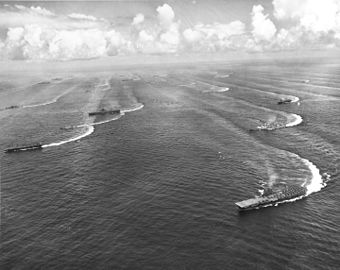
Back الهجوم الأمريكي على اليابان Arabic Slaget om Japan Danish Campaña de Japón Spanish لشکرکشی ژاپن Persian Campagne du Japon French Kampanye Jepang ID Campagna del Giappone Italian 日本本土の戦い Japanese 일본 전역 Korean Kempen Jepun Malay
| Japan campaign | |||||||
|---|---|---|---|---|---|---|---|
| Part of Pacific War | |||||||
 Task Force 38, of the U.S. Third Fleet maneuvering off the coast of Japan, 17 August 1945, two days after Japan agreed to surrender. | |||||||
| |||||||
| Belligerents | |||||||
|
|
| ||||||
| Commanders and leaders | |||||||
|
|
| ||||||
| Casualties and losses | |||||||
| Comparatively light |
193,300 soldiers dead (all causes)[3] Surrendered and captured following blockade and bombings: 4,335,000 soldiers[4] 9,435 artillery pieces 5,286 tanks 731 other AFVs 12,682 aircraft (mostly kamikazes)[5] | ||||||
The Japan campaign was a series of battles and engagements in and around the Japanese home islands, between Allied forces and the forces of Imperial Japan during the last stages of the Pacific campaign of World War II. The Japan campaign lasted from around June 1944 to August 1945.
- ^ The date of Double Strike, which is the beginning of Mainland Air Strike.
- ^ The Archipelago Landing Operation is over.
- ^ "Figures were compiled by the Relief Bureau of the Ministry of Health and Welfare in March 1964". Australia-Japan Research Project. Archived from the original on 11 March 2016. Retrieved 10 March 2016.. Combined death tolls of "Japan proper" (103,900) and Okinawa (89,400).
- ^ Ministry of Health and Welfare, 1964. Archived 2016-01-05 at the Wayback Machine
- ^ Final report: progress of demobilization of the Japanese Armed Forces, 30 December 1946 Part 2, Supreme Command of the Allied Powers, p. 49, archived from the original on 4 March 2016, retrieved 26 December 2015. Artillery is defined as being at least over 80 mm in caliber.
© MMXXIII Rich X Search. We shall prevail. All rights reserved. Rich X Search